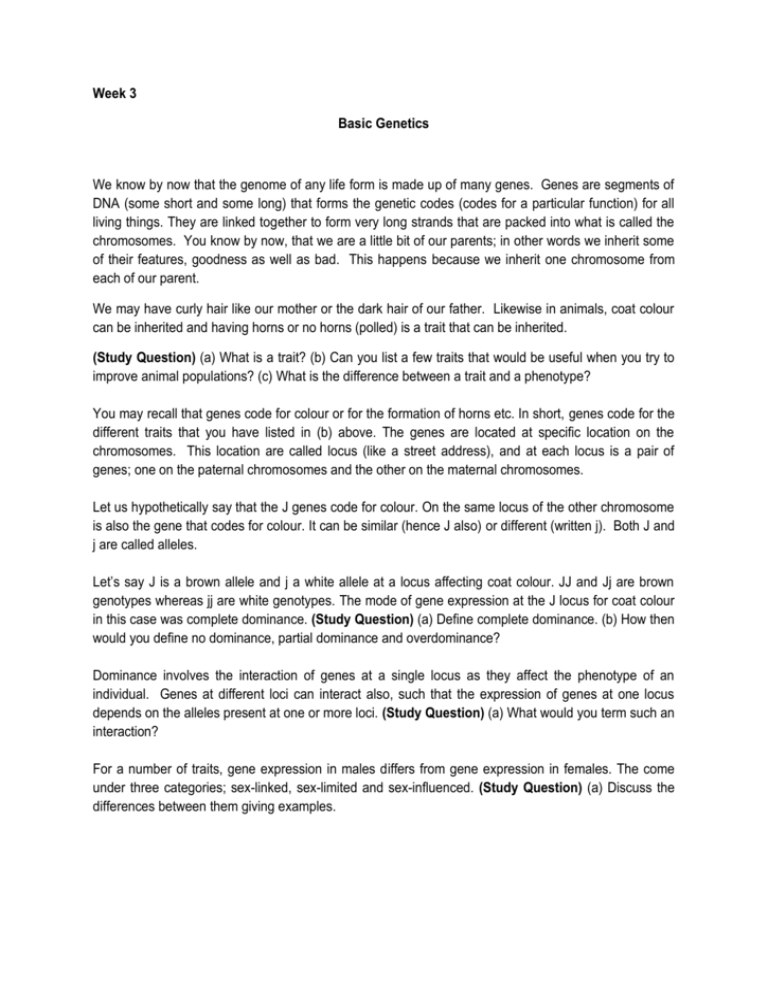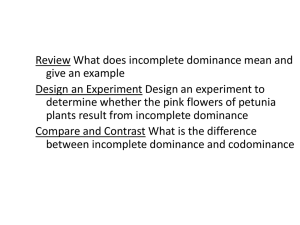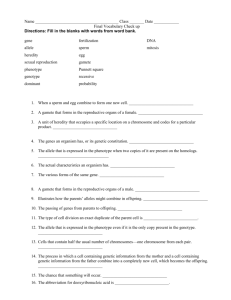Week 3 Genetics - UMK CARNIVORES 3
advertisement

Week 3 Basic Genetics We know by now that the genome of any life form is made up of many genes. Genes are segments of DNA (some short and some long) that forms the genetic codes (codes for a particular function) for all living things. They are linked together to form very long strands that are packed into what is called the chromosomes. You know by now, that we are a little bit of our parents; in other words we inherit some of their features, goodness as well as bad. This happens because we inherit one chromosome from each of our parent. We may have curly hair like our mother or the dark hair of our father. Likewise in animals, coat colour can be inherited and having horns or no horns (polled) is a trait that can be inherited. (Study Question) (a) What is a trait? (b) Can you list a few traits that would be useful when you try to improve animal populations? (c) What is the difference between a trait and a phenotype? You may recall that genes code for colour or for the formation of horns etc. In short, genes code for the different traits that you have listed in (b) above. The genes are located at specific location on the chromosomes. This location are called locus (like a street address), and at each locus is a pair of genes; one on the paternal chromosomes and the other on the maternal chromosomes. Let us hypothetically say that the J genes code for colour. On the same locus of the other chromosome is also the gene that codes for colour. It can be similar (hence J also) or different (written j). Both J and j are called alleles. Let’s say J is a brown allele and j a white allele at a locus affecting coat colour. JJ and Jj are brown genotypes whereas jj are white genotypes. The mode of gene expression at the J locus for coat colour in this case was complete dominance. (Study Question) (a) Define complete dominance. (b) How then would you define no dominance, partial dominance and overdominance? Dominance involves the interaction of genes at a single locus as they affect the phenotype of an individual. Genes at different loci can interact also, such that the expression of genes at one locus depends on the alleles present at one or more loci. (Study Question) (a) What would you term such an interaction? For a number of traits, gene expression in males differs from gene expression in females. The come under three categories; sex-linked, sex-limited and sex-influenced. (Study Question) (a) Discuss the differences between them giving examples. Week 4 Genes in Population (Study Question) Let us consider a flock of 100 Andalusians chickens. In that population, thirty six are black (the alleles at the feather colour locus being BB), 44 are blue (the alleles Bb) and 20 are white (bb). a. What are the gene frequencies and the genotype frequency in this flock? b. In your own words, what do you understand by the term gene frequency and genotype frequency? (Study Question) If I have a herd of 200 goats and 150 of them are brown and the rest white. Assuming J is a brown allele and j a white allele; JJ and Jj being brown and jj white; what would be the gene frequency in that population? Some of the traits we inherit are simply-inherited traits. Examples are coat color and presence of horns. Can you surf the internet and list a few more? With this traits only a single locus or at most a few loci are involved in their expression. In contrast polygenic traits are effected by many genes and no single gene is thought to have an overriding influence. Examples of polygenic traits are growth rates, milk production, difficulty of delivery at birth etc. The genes affecting both kind of traits, are subject to the same Mendelian mechanisms. State the Mendelian laws of inheritance? (Study Question) Go back to the coat colour examples for goats above. If i want to improve a breed based on their coat colours, it would almost be simple. Say I start off with some ferral does, that has a mixture of coat colour. I put them on to a pubred boer sire. What are the characteristics of the offsprings I produce with each generation if I were to continue to breed the offsprings to purebred boer bucks. How would my breeding affect gene and genotype frequency within the population?





